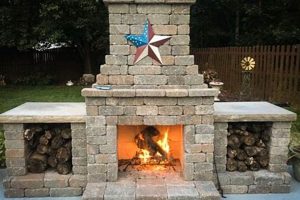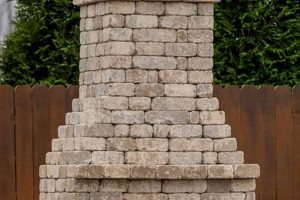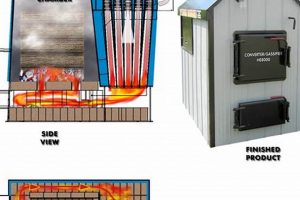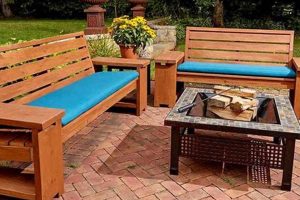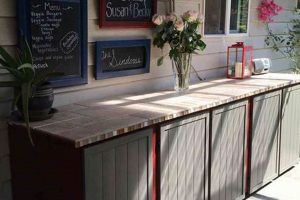A handcrafted, decorative light fixture designed for exterior use constitutes a significant enhancement to outdoor living spaces. These custom-built illuminations offer a unique alternative to standard patio lighting, providing both ambient light and aesthetic appeal. Common examples include repurposed mason jars strung with LED lights, or elaborate structures crafted from metal and adorned with crystals.
The construction of custom exterior lighting offers numerous advantages. It allows for the personalization of outdoor environments, reflecting individual style and taste. Furthermore, the practice often incorporates upcycling and repurposing materials, contributing to sustainable practices and reducing waste. Historically, exterior lighting served primarily functional purposes; however, contemporary trends emphasize decorative elements, transforming outdoor areas into extensions of the home’s interior.
The subsequent sections will detail various construction techniques, material selections suitable for weather resistance, and safety precautions necessary for creating durable and aesthetically pleasing additions to any outdoor setting. Considerations for power source options and mounting methods will also be addressed.
Essential Considerations for Handcrafted Exterior Lighting
The successful fabrication of custom exterior light fixtures requires careful planning and execution. The following guidelines address key aspects of design, material selection, and installation to ensure both functionality and longevity.
Tip 1: Material Selection is Paramount: Opt for weather-resistant materials such as treated lumber, stainless steel, or powder-coated aluminum. These materials withstand exposure to moisture, UV radiation, and temperature fluctuations, preventing premature degradation.
Tip 2: Prioritize Electrical Safety: Employ only UL-rated electrical components specifically designed for outdoor use. Ground fault circuit interrupter (GFCI) protection is essential to mitigate the risk of electrical shock.
Tip 3: Design for Wind Resistance: Consider prevailing wind conditions when designing the structure. A robust and stable design minimizes the risk of damage or displacement during inclement weather.
Tip 4: Implement Adequate Drainage: Incorporate drainage holes or channels to prevent water accumulation within the fixture. Stagnant water can promote corrosion and compromise electrical components.
Tip 5: Select Appropriate Light Sources: LED bulbs are generally preferred due to their energy efficiency, long lifespan, and low heat output. Ensure the selected bulbs are rated for outdoor use and compatible with the fixture’s voltage requirements.
Tip 6: Secure Mounting is Crucial: Employ appropriate mounting hardware and techniques to ensure the fixture is securely attached to its support structure. Consider the weight of the fixture and the load-bearing capacity of the mounting surface.
Tip 7: Consider Light Distribution: Carefully consider the desired light output and distribution pattern. Experiment with different bulb types and diffuser materials to achieve the desired ambiance.
The adherence to these guidelines significantly enhances the safety, durability, and aesthetic appeal of handcrafted exterior lighting. Prioritizing these considerations yields a long-lasting and visually pleasing addition to any outdoor space.
The subsequent sections will delve into specific design styles and advanced construction techniques for those seeking to further refine their handcrafted exterior lighting projects.
1. Material Weather Resistance
The success of any exterior light fixture project is intrinsically linked to the selection of materials exhibiting robust weather resistance. This attribute directly influences the longevity and operational integrity of the structure, as it is continuously exposed to environmental elements. Degradation due to moisture, ultraviolet radiation, and temperature fluctuations can compromise structural integrity and electrical safety. Consequently, employing unsuitable materials can lead to premature failure, increased maintenance requirements, and potential safety hazards.
Consider, for example, an exterior light fixture constructed primarily from untreated wood. Constant exposure to rain and humidity will inevitably lead to wood rot, weakening the structure and potentially causing it to collapse. Similarly, using non-UV-resistant plastics can result in discoloration, cracking, and brittleness, diminishing both the aesthetic appeal and physical integrity of the fixture. Conversely, utilizing materials such as stainless steel, powder-coated aluminum, or treated lumber significantly mitigates these risks, ensuring prolonged performance and safety. Proper selection ensures minimal future cost and effort.
In summary, material weather resistance forms a foundational pillar for any successful exterior lighting project. Ignoring this principle invites premature degradation and potential safety compromises. A comprehensive understanding of material properties and their interaction with environmental factors is therefore paramount for ensuring a durable, safe, and aesthetically pleasing outdoor lighting solution. Further, one may employ various finishing products and treatments to augment resistance.
2. Electrical Safety Compliance
Electrical safety compliance is paramount in the construction of any exterior light fixture. Neglecting established safety protocols can result in severe consequences, including electrical shock, fire hazards, and property damage. Therefore, adherence to relevant electrical codes and standards is non-negotiable when undertaking a handcrafted lighting project intended for outdoor use.
- Use of UL-Listed Components
Employing Underwriters Laboratories (UL)-listed components ensures that each electrical element has undergone rigorous testing and meets established safety standards. Examples include wiring, sockets, and connectors specifically rated for outdoor use. The absence of UL listing indicates a lack of verification, potentially exposing individuals to faulty or substandard materials. The implications of this oversight can range from minor electrical malfunctions to catastrophic equipment failures.
- Ground Fault Circuit Interrupter (GFCI) Protection
GFCI outlets are designed to detect minute imbalances in electrical current, rapidly interrupting the circuit to prevent electrical shock. In the context of outdoor fixtures, moisture intrusion can create a path for electricity to ground, posing a significant risk. Installing GFCI protection on the circuit supplying the fixture provides a critical safeguard against electrocution. Failure to implement GFCI protection leaves individuals vulnerable to potentially lethal electrical hazards.
- Weatherproof Enclosures and Connections
Outdoor electrical connections must be housed within weatherproof enclosures to prevent water ingress. Moisture can corrode electrical contacts, creating short circuits and increasing the risk of electrical shock. The use of weatherproof connectors and sealants further enhances protection against environmental elements. Compromising weatherproof integrity exposes connections to the elements, creating both a safety hazard and a source of potential equipment malfunction.
- Proper Grounding Techniques
Grounding provides a path for stray electrical current to safely dissipate into the earth. Proper grounding of the fixtures metal components minimizes the risk of electrical shock in the event of a fault. This involves connecting all conductive parts to a grounding electrode using appropriately sized grounding conductors. Neglecting proper grounding practices leaves individuals vulnerable to electrical shock in the event of insulation failure or accidental contact with live wires.
The integration of these electrical safety measures is essential for ensuring the safe and reliable operation of any exterior light fixture. Disregarding these protocols introduces unacceptable risks, underscoring the critical importance of electrical safety compliance. Proper installation, inspection, and regular maintenance are crucial to sustaining safety over time.
3. Structural Wind Stability
The inherent design of a handcrafted exterior light fixture must account for structural wind stability to ensure longevity and prevent property damage. A fixture inadequately designed to withstand wind forces poses a safety hazard and represents a financial risk to the homeowner. Proper engineering and material selection are crucial for mitigating the effects of wind loading.
- Aerodynamic Design Considerations
The overall shape and configuration significantly impact wind resistance. A streamlined design, minimizing surface area perpendicular to the prevailing wind direction, reduces the force exerted on the structure. Consider a chandelier with multiple, closely spaced elements versus one with a solid, flat surface. The former offers less resistance and improves stability. Conversely, a design resembling a sail will experience increased stress and potential failure. Understanding aerodynamic principles is essential for creating a stable fixture.
- Material Strength and Rigidity
The materials used must possess sufficient tensile strength and rigidity to withstand the expected wind loads. Lightweight materials, such as thin-gauge aluminum or brittle plastics, are prone to deformation or fracture under stress. Heavier materials, such as steel or reinforced composites, offer greater resistance to bending and breaking. The selection of materials must balance weight considerations with the required structural integrity. Material specifications must be consulted to ensure safe implementation.
- Secure Mounting Techniques
The method of attachment to the supporting structure plays a critical role in overall stability. Weak or improperly installed mounting hardware can compromise the entire fixture, even if the structure itself is robust. Bolting directly into solid framing members or using heavy-duty chains and hooks is essential for secure attachment. Consider the weight of the fixture and the potential for dynamic loading from wind gusts. The proper size and type of mounting hardware must be selected to prevent failure.
- Dynamic Load Calculations
A comprehensive assessment of potential wind loads is essential for ensuring adequate structural integrity. This involves considering factors such as the geographic location, prevailing wind patterns, and the height and exposure of the fixture. Engineering calculations can be used to determine the maximum expected wind force and the resulting stress on the structure. This information is critical for selecting appropriate materials and designing a stable configuration. Failure to properly assess wind loads can lead to catastrophic failure of the fixture during severe weather events.
The incorporation of these elements – aerodynamic design, material strength, secure mounting, and dynamic load calculations – is paramount in ensuring the structural wind stability of any handcrafted exterior light fixture. Adherence to these principles minimizes the risk of damage and ensures the long-term performance of the lighting installation.
4. Effective Water Drainage
Effective water drainage is a critical design consideration in the creation of durable exterior light fixtures. The accumulation of water within the fixture can lead to corrosion, electrical shorts, and compromised structural integrity, significantly reducing the lifespan and safety of the handcrafted illumination. Mitigation of water ingress is therefore paramount.
- Strategic Placement of Drainage Apertures
The incorporation of strategically positioned drainage apertures facilitates the expulsion of accumulated water. These apertures, typically small holes or channels, should be located at the lowest points of the fixture to ensure efficient drainage. Examples include weep holes drilled into the base of the structure or channels integrated into the design of the light shade. Neglecting proper drainage apertures results in standing water, accelerating corrosion and fostering the growth of mold and mildew.
- Material Selection for Water Resistance
The selection of water-resistant materials complements the drainage system by minimizing water absorption and preventing material degradation. Materials such as stainless steel, treated lumber, and powder-coated aluminum inherently resist water damage. When employing less water-resistant materials, such as certain types of wood, a protective sealant or coating is essential. The combination of appropriate materials and a functional drainage system provides a multi-layered approach to water management.
- Design to Minimize Water Collection
The overall design of the fixture should minimize surfaces that promote water collection. Flat, horizontal surfaces tend to accumulate water, increasing the likelihood of corrosion and electrical problems. Sloping surfaces, angled roofs, and rounded edges facilitate water runoff, preventing prolonged exposure to moisture. A thoughtfully designed structure minimizes water retention, reducing the burden on the drainage system and enhancing long-term durability.
- Regular Maintenance and Inspection
Even with proper design and construction, regular maintenance and inspection are necessary to ensure the continued effectiveness of the drainage system. Debris, such as leaves and insects, can clog drainage apertures, impeding water flow. Periodically clearing these obstructions is essential for maintaining optimal drainage performance. Furthermore, inspecting the fixture for signs of water damage, such as rust or rot, allows for early detection and remediation of potential problems.
The implementation of effective water drainage measures is an integral component of constructing long-lasting and safe handcrafted exterior light fixtures. The interplay of drainage apertures, material selection, design considerations, and regular maintenance ensures that water is efficiently managed, preventing damage and extending the operational life of the illumination.
5. Appropriate Light Source
The selection of an appropriate light source is a pivotal decision in the construction of any custom exterior light fixture. The chosen light source directly impacts the fixture’s energy efficiency, aesthetic appeal, light output, and long-term maintenance requirements. Careful consideration of these factors is essential for achieving a successful and sustainable lighting solution.
- LED Technology Advantages
Light Emitting Diodes (LEDs) offer significant advantages over traditional incandescent or halogen bulbs for exterior applications. LEDs exhibit superior energy efficiency, consuming substantially less power for equivalent light output. Their extended lifespan reduces the frequency of bulb replacements, minimizing maintenance efforts and associated costs. Furthermore, LEDs generate less heat, reducing the risk of overheating and fire hazards within the fixture. The widespread adoption of LED technology represents a shift towards more sustainable and reliable lighting solutions.
- Color Temperature Considerations
Color temperature, measured in Kelvin (K), influences the perceived warmth or coolness of the light. Lower color temperatures (e.g., 2700K – 3000K) produce a warm, inviting glow, often preferred for residential outdoor spaces. Higher color temperatures (e.g., 4000K – 5000K) generate a cooler, more modern aesthetic, suitable for security lighting or task-oriented applications. Selecting the appropriate color temperature enhances the ambiance and functionality of the lighting installation. Personal preference and the intended use of the space should guide this selection process.
- Lumens and Light Output
Lumens measure the total amount of visible light emitted by a light source. The required lumen output depends on the desired level of illumination and the size of the area being lit. For ambient lighting, lower lumen values may suffice, while larger areas requiring brighter illumination necessitate higher lumen outputs. Careful consideration of lumen requirements ensures adequate visibility and avoids excessive glare. A well-lit space promotes safety and enhances the enjoyment of outdoor activities.
- Weather Resistance and IP Ratings
The light source must be specifically rated for outdoor use, possessing adequate weather resistance to withstand exposure to moisture, dust, and temperature fluctuations. Ingress Protection (IP) ratings indicate the level of protection against solid objects and liquids. A higher IP rating signifies greater resistance to environmental elements. Selecting a light source with an appropriate IP rating is essential for ensuring reliable performance and preventing premature failure in outdoor conditions. Adherence to safety standards is vital in this selection.
The integration of an appropriate light source is vital for optimizing the performance and longevity of a custom exterior light fixture. The selection process should prioritize energy efficiency, desired color temperature, adequate lumen output, and robust weather resistance. This holistic approach ensures that the lighting installation provides safe, aesthetically pleasing, and sustainable illumination for outdoor environments.
6. Secure Mounting System
A robust mounting system is critical for any handcrafted exterior light fixture. It is the primary interface between the fixture and its supporting structure, bearing the weight of the fixture and withstanding environmental forces. Inadequate mounting can lead to detachment, posing significant safety risks and potential property damage. The following facets elaborate on key considerations for a secure installation.
- Load-Bearing Capacity Assessment
The mounting system must be capable of supporting the static weight of the fixture, as well as dynamic loads imposed by wind, snow, or ice. Calculate the total weight of the fixture, including all components and wiring. Select mounting hardware and attachment points with a load-bearing capacity exceeding this value, with a safety margin of at least 25%. For instance, a 20-pound fixture should utilize hardware rated for at least 25 pounds. Consult local building codes for specific requirements. Improper assessment can result in structural failure under load.
- Material Compatibility and Corrosion Resistance
The materials used in the mounting system must be compatible with both the fixture and the supporting structure to prevent galvanic corrosion. Dissimilar metals in contact with each other can create an electrochemical reaction, accelerating corrosion and weakening the joint. Stainless steel or coated hardware is generally recommended for exterior applications due to its inherent corrosion resistance. Consider using insulating washers or barriers between dissimilar metals to minimize galvanic corrosion. The presence of rust or corrosion indicates a compromised mounting system.
- Appropriate Fastener Selection and Installation
The selection of appropriate fasteners, such as bolts, screws, or anchors, is crucial for a secure connection. The type of fastener must be suitable for the material of the supporting structure. For example, lag bolts are appropriate for wood, while concrete anchors are required for masonry. Follow the manufacturer’s instructions for proper installation, including pre-drilling pilot holes and tightening to the specified torque. Over-tightening can strip threads or crack the material, while under-tightening can result in a loose connection. Periodically inspect fasteners for tightness and corrosion.
- Wind Load Resistance
The mounting system must be designed to withstand anticipated wind loads. Consider the fixture’s surface area and the prevailing wind conditions in the location. Utilize multiple attachment points to distribute the load evenly. Reinforce the mounting structure if necessary, such as adding additional framing members or bracing. Consult local building codes for wind load requirements. A fixture inadequately secured against wind loads can become a projectile, posing a significant safety hazard.
A well-engineered and properly installed mounting system is indispensable for ensuring the long-term safety and stability of a handcrafted exterior light fixture. Neglecting these considerations can compromise the entire installation, leading to potentially dangerous consequences. Prioritizing the secure attachment of an exterior fixture is paramount to its safe operation and longevity.
7. Aesthetic Design Harmony
The concept of aesthetic design harmony represents a critical, often overlooked, element in the successful creation and integration of any handcrafted exterior light fixture. In the context of a “diy outdoor chandelier,” the absence of a cohesive design plan can result in a fixture that clashes with its surroundings, diminishing both its visual appeal and the overall ambiance of the outdoor space. The fixture, intended as a focal point, may instead become an incongruous element, detracting from the intended aesthetic.
The harmonious integration of a custom outdoor light source involves careful consideration of several factors. These include the architectural style of the dwelling, the existing landscape design, and the surrounding environmental elements. A rustic, repurposed chandelier might complement a farmhouse-style porch, while a sleek, modern design might better suit a contemporary patio. Material choices also play a crucial role. The use of natural materials such as wood or stone can create a sense of organic harmony, while the incorporation of metal or glass can introduce a more refined and polished aesthetic. Color palettes, too, must be carefully considered to ensure that the fixture complements the surrounding environment without overwhelming it. The scale of the fixture must be proportional to the space; a chandelier that is too large can overwhelm a small patio, while one that is too small may be lost in a larger setting.
Ultimately, achieving aesthetic design harmony requires a holistic approach that considers the interplay of various elements. A well-integrated “diy outdoor chandelier” elevates the overall aesthetic of the outdoor space, enhancing its visual appeal and creating a more inviting and enjoyable environment. The challenge lies in balancing individual creative expression with the need for a cohesive and harmonious design. A successful outcome reflects a thoughtful and considered approach to both the creation and integration of the lighting fixture.
Frequently Asked Questions
This section addresses common inquiries regarding the construction and implementation of customized outdoor chandeliers. The responses aim to provide clarity on critical aspects of design, safety, and maintenance.
Question 1: Is a permit required for the installation of a handcrafted exterior lighting fixture?
Local building codes often mandate permits for electrical work, including the installation of outdoor lighting. Consult the local building department to determine specific permit requirements within the jurisdiction. Failure to obtain necessary permits can result in fines and potential removal of the installation.
Question 2: What is the optimal height for hanging an exterior chandelier over an outdoor dining table?
A clearance of at least seven feet between the bottom of the fixture and the ground is generally recommended. This height provides ample headroom while ensuring adequate illumination of the dining surface. Adjustments may be necessary based on the specific dimensions of the table and the surrounding area.
Question 3: How can one minimize the attraction of insects to an exterior lighting fixture?
Employing yellow or amber-toned LED bulbs reduces the attractiveness of the light to insects. These wavelengths are less visible to many common insect species, minimizing their attraction to the fixture. Regular cleaning of the fixture to remove accumulated insects is also advisable.
Question 4: What are the key considerations for wiring an exterior chandelier in a wet location?
All electrical connections must be housed within weatherproof enclosures and utilize UL-rated wiring specifically designed for wet locations. Ground Fault Circuit Interrupter (GFCI) protection is essential to mitigate the risk of electrical shock. Proper grounding of the fixture is also crucial. Qualified electricians must always complete wet location wiring.
Question 5: How can one protect a handcrafted exterior chandelier from extreme weather conditions?
During severe weather events, such as hurricanes or heavy snowstorms, it may be prudent to temporarily remove or secure the fixture. Regular inspections for damage and prompt repairs can also extend the lifespan of the installation. Selecting materials designed for resilience against weather elements is vital.
Question 6: What is the recommended maintenance schedule for a handcrafted exterior chandelier?
A visual inspection should be conducted at least twice per year, checking for signs of corrosion, loose connections, or damage. Cleaning the fixture to remove dirt, debris, and insect nests should be performed as needed. Prompt replacement of any damaged or worn components is essential. A detailed maintenance log is suggested.
These FAQs provide a foundational understanding of key considerations for creating and maintaining custom outdoor lighting. Following these guidelines will lead to safer and more satisfactory results.
The subsequent section will explore advanced design concepts and material selection for expert lighting projects.
In Summary
The preceding exposition detailed various facets of the DIY outdoor chandelier, emphasizing material selection, electrical safety, structural stability, water drainage, appropriate light sources, secure mounting, and aesthetic design harmony. Adherence to these principles ensures the construction of safe, durable, and visually appealing outdoor lighting solutions. Deviation from these guidelines introduces potential risks and compromises the longevity of the fixture.
The creation of a handcrafted exterior light fixture represents a significant undertaking requiring careful planning and execution. The synthesis of technical expertise and creative vision yields a personalized and functional addition to any outdoor living space. Rigorous attention to safety protocols and adherence to established engineering principles are non-negotiable elements in the pursuit of a successful outcome. The value of such an endeavor lies not only in the enhanced illumination but also in the expression of individual craftsmanship and the creation of a welcoming and aesthetically pleasing environment. This illumination becomes a statement reflecting care and diligence.



